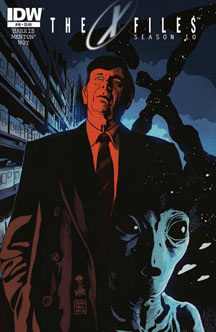After a strong first nine issues, IDW’s “X-Files” Season 10 comics hit a dip in quality from Issues 10-17 (2014). On my first read, this was the point where I started to sour a bit on Joe Harris’ storytelling. On my second read, I realize this was mostly because of the one-month gap between issues. Reading them in one sitting allows the story to flow much better. Still, there is some dense stuff in this batch. As with the heyday of “The X-Files,” your enjoyment will depend on whether you frustrate yourself by trying to understand every little plot point in the mythology, or whether you’re content to grasp the big picture.
On the surface, “More Musings of a Cigarette-Smoking Man” (Issue 10) should be as juicy as Season 10’s previous sequel-to-a-classic-episode, “Hosts” (6-7). While we do get to see Bill Mulder and Cassandra Spender in some of the flashbacks, the overall package is dodgy, largely because the present-day CSM is not the real CSM; he is an alien shapeshifter under the control of – as we learn in the final panel – the Glasses Wearing Man (as he came to be known on the letters page). In fact, the CSM is not merely one shapeshifter, he is an endless string of shapeshifters (as we find out at the end of Issue 15, “Pilgrims, Part 5”) created, programmed and controlled by the GWM. (Granted, the fact that this isn’t the real CSM makes the yarn a nice parallel to Season 4’s “Musings of a Cigarette-Smoking Man,” which didn’t tell strictly real stories from the villain’s past.)
It helps on this re-read that I know the GWM is Gibson Praise, the chess prodigy with alien DNA who was last seen as a kid on the TV series. He is now grown up and using his alien-human-hybrid super-brain power to control these shapeshifters; if memory serves, his endgame is more or less to take over the world.
“Pilgrims” (11-15) is the next big mytharc, following the season-launching “Believers” (1-5). Mulder, Scully and Assistant Director Morales travel to Saudi Arabia to investigate a case that reintroduces staple elements from classics like Season 4’s “Tunguska” and the first movie, “Fight the Future.” Our heroes are menaced by various people under the control of the black oil (Earth’s original alien settlers, as the movie told us). Scully is transported via alien spaceship from Saudi Arabia back to Washington, D.C., as Mulder records “missing time” (a central notion of UFOlogy that I have never totally grasped). Skinner holds Krycek (yes, Ratboy returns from the dead; more on that in a bit) in his apartment, like in “Tunguska,” and Mulder is possessed by the black oil (again, like in “Tunguska”), putting Scully in yet another situation where she has to figure out “Mulder” is not Mulder – this happened a few times in the TV series, and as recently as “Believers,” where a shapeshifter posed as her partner.

Scully is left with a pseudo-amnesia that always accompanies “X-Files” abductions – even unusually brief ones like this. Memory loss is a hard thing to portray in comics – writer Stefan Petrucha also had this problem in his arc that opened the Topps Comics run – because the writers can’t lean on actors playing “confused.”
Krycek is also confused about why he has been thrown into this story; the last thing he remembers is puking black oil out of his facial orifices in “Tunguska.” Harris does an excellent job writing the shifty character made famous by Nicholas Lea; so often on the show, a viewer wanted to trust him even though we knew we shouldn’t, similar to voters during election season. But in “Pilgrims,” his return from the dead — he was clearly gunned down by Skinner in Season 8’s “Existence” — is so bizarre that it makes sense to believe Krycek’s confusion.
It turns out that the villain of this grand scheme (later revealed to be Gibson Praise) has the power to yank Krycek from right after his black-oil possession in 1996 and bring him into modern time to use as an agent. Or something like that. Krycek’s return – on the heels of the CSM’s “return” – smacks a bit too much of a “greatest hits” album, even with Harris capturing Ratboy’s voice. And Praise’s ability to pull people through time like that is arguably too incredible of a power to be plausible or compelling. Yes, “The X-Files” touched on time travel in the Season 4 standalone “Synchrony,” but the mytharc is dense enough without throwing time-travel conundrums into the mix.
“Immaculate” (16-17) is the weakest Season 10 monster-of-the-month yarn up to this point, albeit one featuring a cool cameo. It starts with a “pre-credits” sequence in the finest tradition of “The X-Files,” as a visibly pregnant woman named Joanie Cartwright enters an abortion clinic. Just as the doctor is about to begin the procedure, the receptionist realizes this same woman had an abortion mere months earlier; it’s not a baby she’s carrying, but rather a bomb. However, as the clinic goes kaboom, the woman walks away unharmed.
But “Immaculate” doesn’t go anywhere from there; Harris doesn’t delve deeply into abortion from either side of the issue (although one could argue the fact that Joanie is possessed by the Devil is a stark commentary on abortion). Everyone in this small North Carolina town seems possessed – calling to mind Season 2’s “Die Hand Die Verletzt” and “Our Town” and several other “odd townsfolk” yarns – but in three different ways: One group follows Joanie, one group claws their eyes out (like in Season 5’s “Chinga,” where an evil doll makes them do it) and members of the third faction – the abortion protestors — are redundantly shot to death AND scared to death by Joanie’s faction.
“Millennium’s” Frank Black makes his comic-book debut in Issue 17, which also marks his first appearance of this millennium (his prior appearance was in the “X-Files” Season 7 episode “Millennium,” which aired in 1999). The psychic Black implies to Mulder than Joanie is possessed by the Devil (or possibly an incarnation of the Devil), but it’s weird that he doesn’t clearly spell this out to Mulder, who assures Frank that “When it comes to the paranormal, I’m ready to believe you. Ask around.” Frank beats around the bush, presumably for the sake of maintaining the mystery, but it would’ve been more fun to hear Black and Mulder speak frankly about this case, something neither of them can do around most people. Sometimes the Frank-vs.-the-Devil stories (the Devil is Lucy Butler, played by Sarah-Jane Redmond) worked well on “Millennium” thanks to the show’s deliciously dark mood, but there’s not much depth or intrigue to this conflict in the comic pages.
Still, it is nice to see Frank Black return after a too-long absence (even with “The X-Files” TV revival, it seems unlikely Lance Henriksen will get to reprise his role). Issue 17 was somewhat of a teaser for a five-issue “Millennium” miniseries that followed in early 2015, and which I will review in a future flashback post.

